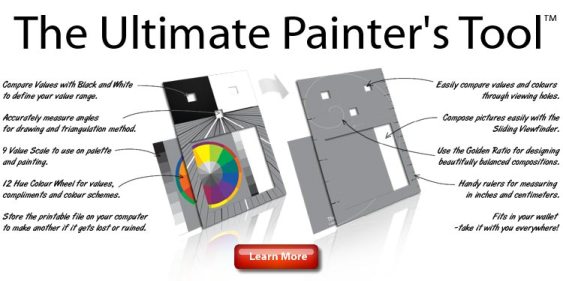How to Use a View Finder to Compose a Painting
When photographers are trying to capture a scene, they have the added convenience of a viewfinder built into their camera. What we can take in with our eyes is a lot greater than what a photograph or a painting can convey, so the viewfinder helps narrow that focus to what will actually fit on the rectangular artwork. Unfortunately for painters, composing a scene isn’t as readily easy as it is for photographers. When staring out at a large landscape for instance, it can be difficult to isolate a section that you want to focus on. Luckily, there are makeshift viewfinders for painters to use in order to help compose their paintings. Get a Viewfinder First you need to get some kind of object you can use as a viewfinder. An empty picture frame can quickly be repurposed for this function, but you may want something that offers a bit more flexibility in terms of shape. What’s better than a hollow rectangle like a picture frame is two L-shaped pieces, effectively splitting the rectangle from corner to corner. This will allow you to change the size and shape of the image within the viewfinder easily. You can make your own viewfinder quite easily out of cardboard or cardstock. In a pinch, use the thumb and index finger of each hand to make two L’s and frame the image this way. How to Use It If you know what size your canvas is going to be already, position the viewfinder in this shape. If you’re still open to the options (which is probably better, since the best way to frame your scene may not necessarily be in the shape of your canvas), try many different orientations with your L’s. You can pull them apart horizontally to see what a wide, squat painting would look like, or do the same vertically to better envision a tall, narrow painting. You can even see what a square painting would look like—it could very well be the best option. Move it around across the scene like you would a camera, and see which part makes the best composition. Tips When you find a composition you like, make a solid mental note of what’s inside the frame. You don’t want to drop the viewfinder to start sketching and then realize you’ve forgotten where you had it focused. If your scene is very large, you may want to divide your sketch into four equal parts and then reposition the viewfinder to frame each quarter while you sketch. This is a bit like using the grid method when copying a work, focusing on one piece at a time. If you’d like, you can even set up your viewfinder to somehow hang in front of the scene so that it frames your composition perfectly from the angle at which you are painting. Making and using a viewfinder is very simple and is something that can be a tremendous help if you’re having difficulty isolating a part of the scene to focus on. It only takes a minute to do and using it can be the difference between a good and a great composition. | |
|


Master the Colours DVD...

|
Although every attempt has been made to make information as accurate as possible, we are not responsible for any errors that may appear.
© Copyright 2015, OilPaintingTechniquesLessons.com. All Rights Reserved.





